If you follow the news, you must have seen her face. Awkwardly serious and surprisingly mature in speech, 16 year old Greta Thunberg from Sweden is currently one of the hottest names in global politics. Thunberg has been making headlines since 2018 when she first ditched school in order to protest against climate change. She has inspired thousands of people to act with her, collecting numerous accolades for her courageous attitude and countless public appearances.
Thunberg describes herself as a “climate activist with Aspergers.” According to her, this condition is one of the reasons she is able to focus so deeply on the ecological crisis and be a more effective campaigner – to “see through environment lies” as she put it in a recent interview. No wonder she’s now using the greatest ‘gifts’ she unwittingly received in order to fight back.
According to Masha Gessen in the New Yorker,
“Greta’s protest serves a dual purpose. It not only calls attention to climate policy, as she intended, but it also showcases the political potential of neurological difference. ‘I see the world a bit different, from another perspective…I have a special interest. It’s very common that people on the autism spectrum have a special interest.”
This makes sense, since according to the National Autistic Society, people with Aspergers often have a tendency towards repetitive patterns of behaviour and a single-minded pursuit of interests. Thunberg’s brain may therefore be wired towards constant action and extraordinary focus, so it is perfectly suited for a tireless fight against global inaction on climate change. “It’s either you are sustainable or not — you can’t be a little bit sustainable” as she puts it. For her, things are as simple as they sound.
What’s not so simple are the connections between environmental factors and our mental and physical wellbeing. Air pollution and an excessive exposure to toxins have been found to affect the brain not only in adults but also in children, because inhaled pollutants can be transferred from the mother to the fetus during pregnancy. According to the World Health Organisation nine out of every ten people breathe toxic air daily. This means that almost every child currently living on the planet or in their mother’s womb is at risk.
But air pollution is just one factor in determining the overall toxicity of the environment. In addition, toxic chemicals are added to pretty much everything we use, including food, household items, personal care and beauty products, toys, furniture and clothing. These chemicals can easily enter the human body through inhalation, orally or through our skin, attacking our immune systems and ultimately wreaking havoc on our health. Children are most vulnerable to these effects because their immunity is usually weaker than that of an adult. This is shown by studies that suggest (but don’t yet prove) a link between prenatal exposure to man-made chemicals and an increased risk of Attention-Deficit Hyperactivity Disorder (ADHD), less optimal long-term memory in adolescents, and lower intelligence levels in children.
The levels of toxicity in our environments are currently unprecedented. In the US alone, it is estimated that approximately 27 trillion pounds of chemicals are produced or imported per year. This amounts to 226 pounds (102.5 kg) of chemicals per person per day. What’s particularly worrying is that very few of these chemicals have ever been tested for safety. The 1976 Toxic Substances Control Act requires that chemical substances in the US be tested for any ill effects before approval only if evidence of potential harm already exists. This is seldom the case for new chemicals, and in reality, about 90 percent of the new compounds are approved without restrictions. ‘We don’t know what we don’t know’ as the saying goes, and that is precisely the problem, especially because the ultimate burden of testing is therefore left to us and our own health.
However, we do know that toxicity has been linked to an increasing range of diseases including cancer, digestive distress and mental health problems. As an example, phthalates that are usually found in food packaging, shower curtains, detergents, shampoos and nail polish have been linked with fertility issues, neurological disorders and cancer. Another common chemical compound found in furniture foams, mattresses, carpets and commercial aircraft – flame retardants – has been found to disrupt hormones and significantly affect women’s reproductive health. This is especially acute among flight attendants who are the most exposed to flame retardants and other chemicals from airplane materials, and who have been found to have higher rates of cervical, thyroid, breast and gastrointestinal cancers.
Hence, the toxicity of the environment is a hugely problematic issue with potentially significant effects on everyone’s health, and even on our ability to reproduce. However, the current environmental debate focuses predominantly on the results of CO2 emissions, rising sea levels and animal species extinction. These concerns are absolutely valid and need to be acted on immediately. But in reality, they’re just the tip of the iceberg. While the ecological crisis is now scientifically confirmed, the public health crisis with which it’s associated has received much less attention. In 1965, only 4% of Americans had a chronic disease. Today, 46% of American children have one, though some of this increase is probably related to better diagnosis.
Despite these horrifying statistics, the links between health and the environment are often ignored or sidelined in environmental activism and public policy. Even the Green New Deal agenda, led by Alexandria Ocasio- Cortez in the US and its sister programmes in Europe, lack any deep consideration of the deteriorating health of our populations and its connection to the ecological crisis. That connection is not magic, it’s common sense. According to the latest research in microbiology, only 43% of the human body is made up of human cells. The rest is made up by tiny organisms such as microbes, bacteria, viruses and fungi. Humans are not separate from their environments – those environments are lodged deep inside us.
The environmental question is about the present as much as the future. It concerns our daily wellbeing as well as our long-term health, the dignity of human life and our ultimate survival as a species. It impacts on everyone currently living on planet earth and anyone who is yet to arrive here. Today, we are not even able to guarantee fair access to clean air to anyone born on this planet, whether in high- or lower-income countries. This is precisely what Thunberg’s call not to steal her and all our futures is all about – and the reality we all need to wake up to.
This article was amended on May 29 2019.





